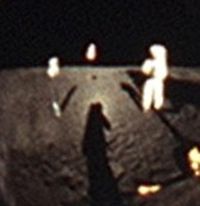Opposition surge

Have you ever seen a shiny object like a mirror or a puddle of water and noticed that it looks much brighter when you look at it from a certain angle? That's because of something called opposition surge!
Opposition surge happens when sunlight hits a surface, like a planet or the Moon, and reflects back to our eyes. When that surface is at the same angle as the Sun, the sunlight all bounces back in the same direction, making the surface look much brighter than it would otherwise.
It's like if you were standing in a dark room with a flashlight, and you pointed the flashlight straight at a white wall. The wall would look very bright because all the light from the flashlight would be reflecting straight back to your eyes.
Opposition surge is especially noticeable on the Moon, because it doesn't have any atmosphere to scatter the light. So when the Moon is at opposition (meaning it's on the opposite side of the Earth from the Sun), it looks much brighter than usual!
Scientists study opposition surge to learn more about the surfaces of planets and other objects in space. By measuring how bright they are at different angles, they can learn about things like the composition and texture of the surface. Scientists can also use opposition surge to help plan missions to places like the Moon or Mars, where they might want to study the surface up close.
Opposition surge happens when sunlight hits a surface, like a planet or the Moon, and reflects back to our eyes. When that surface is at the same angle as the Sun, the sunlight all bounces back in the same direction, making the surface look much brighter than it would otherwise.
It's like if you were standing in a dark room with a flashlight, and you pointed the flashlight straight at a white wall. The wall would look very bright because all the light from the flashlight would be reflecting straight back to your eyes.
Opposition surge is especially noticeable on the Moon, because it doesn't have any atmosphere to scatter the light. So when the Moon is at opposition (meaning it's on the opposite side of the Earth from the Sun), it looks much brighter than usual!
Scientists study opposition surge to learn more about the surfaces of planets and other objects in space. By measuring how bright they are at different angles, they can learn about things like the composition and texture of the surface. Scientists can also use opposition surge to help plan missions to places like the Moon or Mars, where they might want to study the surface up close.
Related topics others have asked about:
